“Why Are We Hungry?” will return next week. Meanwhile, I recommend you read it starting from Part I if you haven’t already, because Part III, and particularly Part IV, throw quite a bit of light on currently hot issues.
Adaptation to endurance exercise is important, because our ability to burn fat for energy is important:
J Appl Physiol. 1984 Apr;56(4):831-8.
Adaptations of skeletal muscle to endurance exercise and their metabolic consequences.
Holloszy JO, Coyle EF.The major metabolic consequences of the adaptations of muscle to endurance exercise are a slower utilization of muscle glycogen and blood glucose, a greater reliance on fat oxidation, and less lactate production during exercise of a given intensity. These adaptations play an important role in the large increase in the ability to perform prolonged strenuous exercise that occurs in response to endurance exercise training.
However, one of the biggest problems with endurance training is diminishing returns. Holloszy and Coyle again:
Regularly performed endurance exercise induces major adaptations in skeletal muscle. These include increases in the mitochondrial content and respiratory capacity of the muscle fibers. As a consequence of the increase in mitochondria, exercise of the same intensity results in a disturbance in homeostasis that is smaller in trained than in untrained muscles.
Furthermore, though prolonged endurance exercise results in greatly increased fat oxidation, it also causes a period of decreased mitochondrial efficiency that lasts for at least 28 hours afterward…and probably longer.
Maria Fernström,1,2 Linda Bakkman,1,2 Michail Tonkonogi,2,3 Irina G. Shabalina,2 Zinaida Rozhdestvenskaya,2 C. Mikael Mattsson,1,2 Jonas K. Enqvist,1,2 Björn Ekblom,1,2 and Kent Sahlin1,2
Reduced efficiency, but increased fat oxidation, in mitochondria from human skeletal muscle after 24-h ultraendurance exercise
Journal of Applied Physiology May 2007 vol. 102 no. 5 1844-1849The most important novel findings of the present study were that 1) mitochondrial efficiency decreased after ultraendurance exercise and remained reduced after 28 h recovery; 2) mitochondrial FA oxidation (state 3) and relative FA oxidation [PC/(PC + Pyr)] increased Post-Ex; and 3) noncoupled respiration rate (state 4) was reduced after 28 h of recovery.
Given these facts, we can easily see why “chronic cardio” produces more injuries than it does fitness. Continually pounding out the same mileage, day after day, quickly strands us on a performance plateau of diminishing returns—both in performance and in physique.
Here’s an alarming example, summarized from the above study by one of its authors:
Bakkman, Linda
Mitochondrial function adaptations to changed metabolic conditions
Department of Medicine, Solna, Karolinska Institutet, Stockholm, Sweden, 2010“…The nine subjects were elite ultra-endurance performance athletes, all men. They had an impressive exercise background with 3-9 years of regular extreme endurance exercise and recent merits from national and international championships. … The group had a body fat content of an average 16.9% (range 10.8-26.1) of body weight, which is typical for males of their age.”
So much for the hypothesis that exercise, by itself, is enough to lose fat. If international ultra-endurance champions still carry a “typical” load of 17% bodyfat, how can the rest of us hope to attain the physique we’d like?
Beating The Law Of Diminishing Returns: Occasional Insanity Trumps Daily Misery
As Holloszy and Coyle make clear, the first feat of endurance at a given duration and intensity produces the greatest increase in respiratory capacity. So in order to bring ourselves to a high level of performance, it seems likely that occasional ridiculous efforts would produce the same adaptation as daily lower-intensity effort, for a much smaller time commitment and much less damage to our joints and heart. As I said in "Eat Like A Predator", “The only way to improve is to push your limits.”
To that end, I bring you…
22 Miles, 6200′ Up, 6200′ Down, Zero Calories: Mt. Whitney, Fasted
Inspired partially by Asclepius’ journey, I day-hiked Mt. Whitney—the tallest mountain in the 48 continental United States—on my way home, after the Ancestral Health Symposium. In other words, my training program involved sitting in a chair and listening to presentations…at sea level.
Would-be hikers start at 8,300 feet (2530 meters), and climb almost 6,200 feet (1890 meters) in 11 miles (17.7 km), on their way to the summit at 14,497 feet (4491 meters), before returning down the same trail for a total of 22 miles (35.4 km) and 12,400 feet (3780 meters) of elevation change. (Click here for relief maps, and all the information you could want about attempting it yourself.)
Most people take two or three days, camping at altitude to acclimate…but a substantial number attempt it as a day hike. Since I live at over 6000′ and am in reasonably good shape, I decided that it wasn’t enough of a challenge, and it would be a good test of my metabolic flexibility and ability to oxidize fat if I did the entire hike completely fasted. No breakfast, no energy bars, no sandwiches, no gorp, gels, blocks, shots, powders, or electrolytes. Water and my own fat would have to serve.
Did I mention I also used minimal shoes?
My hike started here, at the Whitney Portal parking lot, where delinquent bears had recently thrown a party.
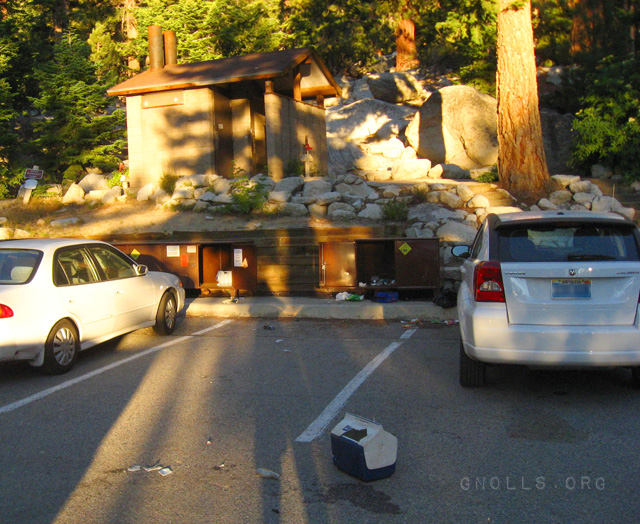
There is an apocryphal quote, usually attributed to a Yosemite park ranger, about designing bear-proof containers: “There is considerable overlap between the intelligence of the smartest bears and the dumbest tourists.”
These food storage boxes were installed so that people don’t leave food in their cars at the trailhead: even a small black bear can easily break into a car, using nothing but its own strength. I suspect what happened here is that some people didn’t properly close the “bear boxes” after stashing their own food. There are two kinds of bear box: one uses a simple hidden latch, but the ones pictured use a sort of Allen key on a chain and are much trickier to open and close.
I found one of the simple ‘hidden latch’ type, and my cooler was safe upon my return.
2000 feet of altitude and several miles later, Whitney Portal is barely visible, with the Owens Valley beyond.

A record snow year meant the creeks were still running. Balance was required.
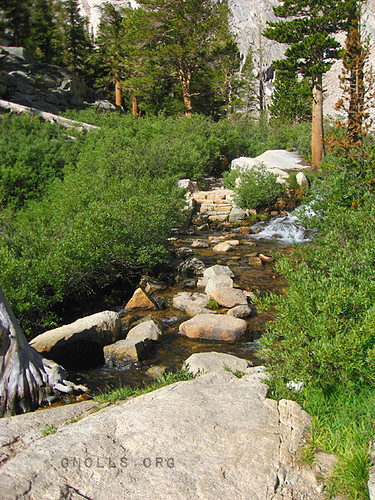

This is the last tree you’ll see. Note the saddle in the far distance: that’s where the previous picture of the Owens Valley was taken from, just a couple hours ago.

Now we’re in the high alpine. Progress slows somewhat at 13,600′ altitude, and I admit to having felt somewhat lightheaded. I’m not sure whether it was a lack of air or lack of calories, but a short rest at Trail Crest solved my problems.
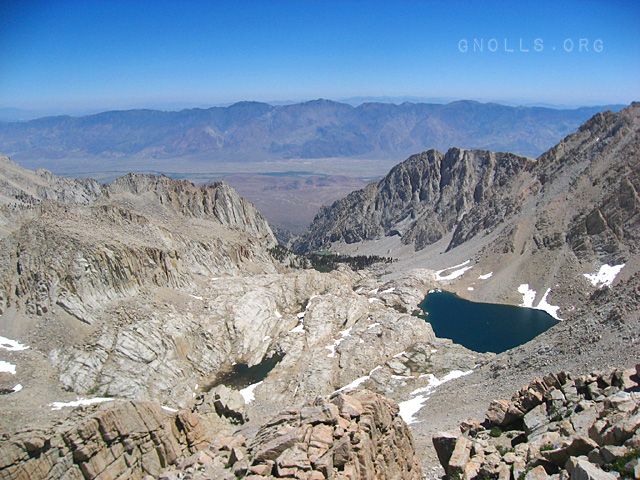
Looking the other direction from Trail Crest:
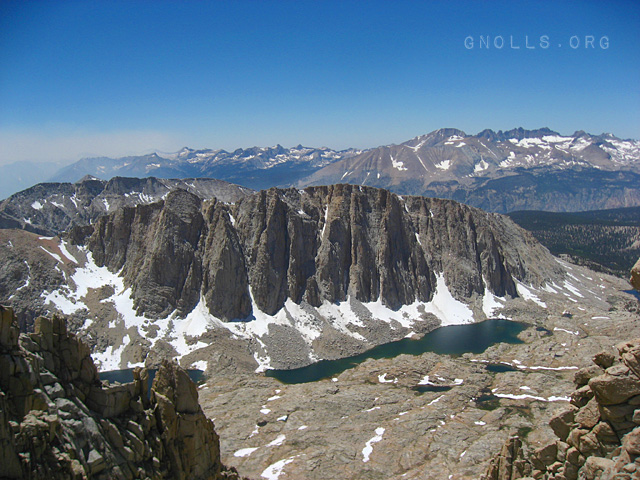 (The haze in the valley is due to a large wildfire to the south.)
(The haze in the valley is due to a large wildfire to the south.)
This hike isn’t like running 22 miles on flat pavement: there are many miles of trail that look much like this:

But persistence and a steady pace soon placed me at the summit. Note the cheap skate shoes—which were actually quite functional, having both great ground feel and robust toe protection:

Whereupon I enjoyed stunning views of the entire Eastern Sierra that photographs simply cannot convey, and a relaxed hour or so on top of the world.
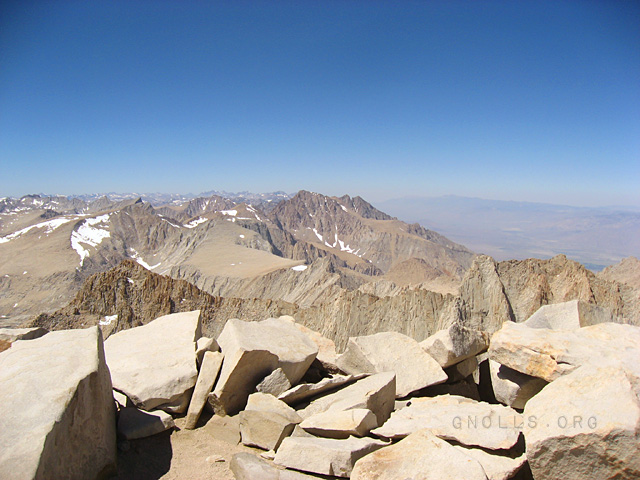
Life establishes itself anywhere it can, even at 14,000 feet:
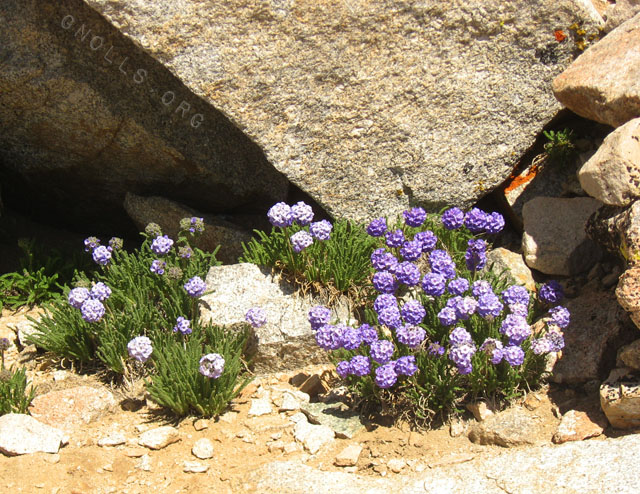
And on sheer granite walls, where every shelf and crevice supports a tree:
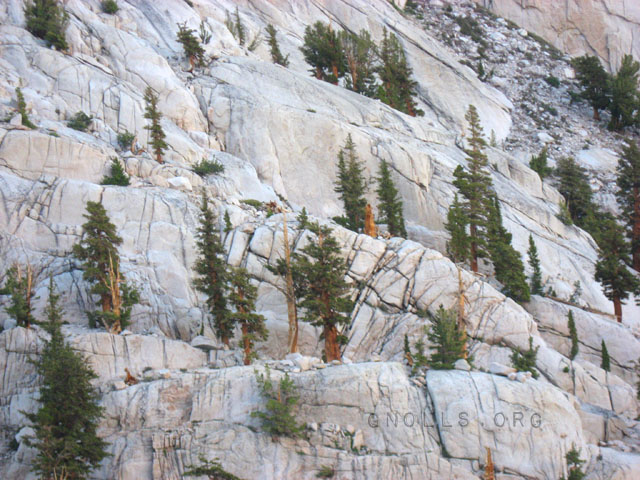
The pictures end here, but the hike continued. I must admit that the final few miles, descending from Outpost Camp, were a grind…I wasn’t desperate or in pain, but I was quite ready to be back at my car, sitting down and eating the delicious gravlax, Greek yogurt, and blueberries I had stashed in a cooler.
Some notes on the journey and recovery, in no particular order:
- I didn’t feel hungry at all during the entire six-hour descent from the peak—and my hunger was totally manageable on the way up. Eating a diet high in saturated fats, primarily from meat and coconuts, appears to have increased my ability to oxidize my own fat for energy.
- I had to stop and rest a couple times on the ascent, but I never felt drained or helpless…just like I had got a bit ahead of my ability to produce energy.
- Since I wasn’t eating, I didn’t need to drink much water. In fact, though I brought water bottles, I only ended up drinking water where it was naturally available—so I could have done the entire hike carrying nothing but a windbreaker! (Note: not recommended.)
- Another benefit: Mt. Whitney is very heavily traveled, so hikers must pack out all their own poop. Not eating also meant not having to poop in a bag and carry it around with me all day.
- I felt fine the next day, though not sprightly, and hiked perhaps another seven miles. Neither was my appetite out of control: my body only went into recovery mode once I did nothing for most of a day, whereupon my appetite and sleep deficit caught up with me. (It felt like I was ready to keep going as long as there was a crisis, and my body only demanded recovery once the crisis was over.)
- I am not, to my knowledge, a gifted athlete. This is not a feat out of reach for any reasonably healthy human, given proper diet and a level of regular physical activity. (If you haven’t ever walked five miles on flat ground, Mt. Whitney is not the place to start.) What will stop you is injuries or degenerative disease, which are your real limitations.
- I could have easily kept hiking if I had to. My feet hurt a little from walking on sharp rocks all day, but I still had energy left to keep going.
To elaborate on this last point: Our capacity for energy storage, as fat, is basically infinite as it applies to a single day of physical effort, or even multiple days: 3500 calories per pound of fat goes a long way. Our limitation is the rate at which we can burn it for energy…
…and that is what we increase by pushing the limits of our endurance: the base rate at which we can keep going all day, and all night if we must. Fat oxidation is the foundation atop which all our impressive feats of momentary strength and quickness are built.
Where Are Your Limits?
We’re all quite comfortable here at our computers, with a solid roof over our heads, central heating, clean running water, enough to eat, and an only mildly dysfunctional government and police force…
…but life isn’t always so easy. Earthquakes and tornadoes, floods and tsunamis, wars and revolutions, genocides and epidemics and famines. The Rape of Nanking, the Trail of Tears, the Indonesian Tsunami, the Spanish flu, the Cultural Revolution, … the death toll of natural and human-caused disasters is beyond all comprehension.
Ask yourself: would you be a victim, a refugee, or an emigrant?
Live in freedom, live in beauty.
JS
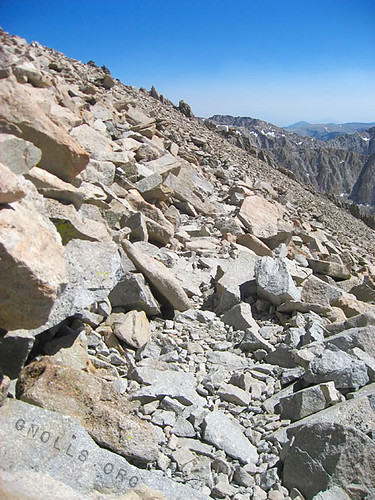


Inspiring photographs! Stunning scenery!
Some of my experiences were very similar to yours – notably the sensation that at times I had got ‘a bit ahead of my ability to produce energy’ (walking in a group meant I had to go at their pace rather than mine). Similar to yourself, the next day I was not ravenously hungry as I had expected, and felt my body had prepared itself for more work, that it was ramped up in expectation of more of the same. IIRC, a day or so later, ‘post-crisis’, the ‘cost’ of the adventure became ‘payable’ – and I both ate more and rested more!
Interestingly, my last ‘epic’ adventure (Coast to Coast by bike over three days), was not so easy to overcome. Something I hope to blog about in due course.
Really enjoyed this post. Thank you!
Really inspiring story and accompanying photographs – I've googled for more views of the area.
I reckon I'm about half way through my fat loss journey, but dramatically more energetic and able to take on long walks and take in completely off trail experiences which push me beyond what I thought I was capable of – literally clawing up muddy slopes at times. I love that stuff.
I engage in moderate activity every day, including walking, some unpredictable weights (water bottles, bags, sledgehammer, tyres, that kind of thing) and resistance against my own muscles as a good warm up.
I think I'll take up this idea and go for a long walk one day … just wake up and go for it!
Inspiring! The science bit at the beginning was useful.
I hope that is not your cooler of berries, yogurt and fish. That means you have a hole in your car.
Very cool idea – thanks for sharing!
Beautiful. Thanks for sharing. It’s ironic that you mention earthquakes…We had one in DC yesterday, and although it wasn’t huge (5.8) it definitely caused a panic because we’re not used to them here. The trains and buses were all overloaded, so I decided to just walk the few miles home. Got a couple of blisters from non-ideal shoes, but otherwise was just fine and could have done a lot more if I needed to. Nothing like the harrowing tale Jamie Scott told about the Christchurch earthquake, but it made me feel good that I didn’t even hesitate about walking…
Lovely post – although I had a shock when you mentioned greek yogurt?!
That’s awesome. I can always count on you to be as weird as me. Last night I fasted. I ate a good amount of food around 11am and didn’t feel like eating again till late at which time I just decided to reap the benefits of IF.
While I’m fasting I often go do something active. Last night it was a walk all over town and play in the river with my daughter and come home and write an article. 2 weeks ago it was a bike ride all over town pulling my daughter behind me in a trailer.
Food is, well, overrated. 🙂 We’ve got to eat, of course, but we also don’t have to eat as often or as regularly as people think. I know you are an efficient fat burner as am I and your body probably didn’t experience the kind of stress which most others would experience if they were to try to do the same.
I love how you suggest we push our limits beyond comfort and even sanity because, you’re right, the real world (beyond our modern conveniences) would never have allowed such a luxury of inactivity and safety.
Such breathtaking scenery. How could anyone dwell on their personal limitations while immersed in the vast bounty of nature? Compelled by the ancient impulse to venture along the trail, food itself would be an unwelcome distraction.
Confined as I am to an urban environment, this seems like an imaginary paradise to me. How different it must feel, hopping through cool streams and breathing pure, rarefied air, rather than dodging broken glass and timing one’s breath to avoid lungfuls of auto exhaust. Even the dawning sunlight in the parking lot, with its vivid yellows unfiltered by smog and long shadows drawn from an infinite horizon, seems to me like a vision of a legendary afterlife.
Good grief, how far we have strayed from our ancestral legacy. As much as I appreciate your scientific insights, JS, I am equally grateful for these occasional glimpses into your arboreal peregrinations. They open my mind to the possibilities of a world outside the urban oubliette.
Quite impressive, JS! 22 miles at altitude with 6200′ elevation gain in a single day is quite a strenuous undertaking. You must be in good shape. I’ve had plenty of stiff, sore legs from 12 mile hikes in the mountains.
Asclepius:
I think that if we're working under our basal rate of fat oxidation, we can go pretty much forever. The problem is that real-world effort often requires little bursts of energy, which come at a large premium after 12+ hours of continual effort. Avoiding them whenever possible is the key to ultra-endurance.
Samantha:
You're welcome! I like to emphasize that 'paleo' is a tool that allows us to live fulfilling lives, not an end in itself.
Paul:
Absolutely! You're capable of more than you think you are.
Note that I carried food with me in case of a crisis: being rescued by a helicopter isn't “paleo”.
Tim:
No, it wasn't. That picture was taken at the beginning of the hike, and features someone else's coolers and trash. I've added an explanatory note to the article.
Christopher:
AHS was wonderful, but I felt the need to get out and actually do something ancestral and healthy afterward.
Katie:
That's exactly the point I'm making at the end of the article. If gasoline supplies are interrupted or highways are blocked, how are you going to feed yourself and your family, let alone escape the area? Most people are effectively paralyzed without their cars, and they don't need to be.
Ash:
As a functional paleo eater, I don't proscribe high-fat dairy for those who tolerate it well — as I appear to. I do minimize casein and lactose, from which any health issues spring, so I very rarely eat cheese and never drink milk. The Greek yogurt I eat periodically is over 80% fat, contains very little protein, and the lactose has essentially all been fermented.
Peggy:
Absolutely. One of the biggest benefits of paleo, for me, has been that food no longer controls me. All my life I had to eat every 3-4 hours or I became cranky and irritable. I still enjoy food greatly…but I don't need constant sugar hits to keep me going. Metabolic flexibility for the win!
Timothy:
I worked in cities for many, many years to be able to move to Tahoe…which is still more far urban than Lone Pine, the Eastern Sierra town nearest Whitney. It's been worth it: though my lifestyle involves less techno-toys, I could never have written The Gnoll Credo in a city.
“The urban oubliette” is a great phrase. As we live our lives, our focus slowly narrows to only that which is directly in front of us — unless we make special efforts to widen it. If we're not careful, we find ourselves with wrinkles and gray hair, suddenly realizing that we'll never do all the things we always thought we would.
I don't know how old you are, but my advice is this: your first goal in life should be to figure out a way to support yourself that doesn't depend on your physical location. Then you can move to wherever makes you happy. You'll probably have to settle for a lower income and lower standard of living…but even a vacation destination usually has lower cost of living than a city, and I value being able to (for instance) ride singletrack trails out the door of my house over owning an expensive new car.
Paul:
I'm in good shape — but I'm not an exceptional athlete. Like I said to Asclepius, if we're working under our basal rate of fat oxidation, our limitation becomes injuries and physical degeneration, not strength or endurance. And I find that periodic craziness like this, plus small amounts of daily exercise, leaves me in far better shape and spirits than “chronic cardio” ever did.
My point isn't to brag: people day-hike Whitney every summer day, though the ones I talked to thought I was crazy for doing it fasted. My point is that most of us are capable of far more than we realize — and pushing our limits periodically is most likely far more effective than a much greater amount of total effort that always remains comfortably under our limits.
Dealing with the soreness: I think that recovery after such heroic efforts is one time where it's best to overconsume protein. And stretch…I find myself stretching every few hours in order to keep my muscles from healing in a tightened state, which also seems to decrease the net stiffness and soreness.
Your latest thyroid article is amazing, by the way. It'll take me a few more readings to fully process it, but I'm already seeing some of the connections you've made.
JS
JS, you speak important truth. At 35, I am old enough to understand that but still young enough to do something about it. The logistics of escape are complicated by my two baby sons, but for their sake and my own, we will find our way out. And they will learn that an urban lifestyle is an exercise in nerga.
Speaking of which, the Gnoll Credo is bowling me over. It has shocked me and moved me and infected my dreams. I’m halfway through, savoring each page, wishing it would never end.
He, I’m jealous 😛
In fact, I just fired up google maps. There are no mountains around but there should be somewhere to walk away from civilization for an afternoon. I’m just not sure if I can cross a bridge, but I’ll find that out tomorrow.
Loved this post, and also loved this comment by Timothy: “How could anyone dwell on their personal limitations while immersed in the vast bounty of nature?”
I just took a holiday to Switzerland and was amazed at the boundless energy I experienced when a new and gorgeous alpine vista was around every corner.
Timothy:
Thank you. I took great pains to make sure every sentence of TGC was meaningful and without extra words. It's Gryka's story, and I've done my best to honor her by telling it as best I can.
Once you realize escape is a function of income untethered to location, it gets a lot easier. People focus on trying to get a “job” out in the country, which is hopeless. If jobs paid anything it would be a city, not a town or the country.
Fmgd:
Exploring is part of the fun…being somewhere you've never been.
I deliberately didn't take any maps with me: I wanted to be in my surroundings, not at a point on a map. Maps can help, but they also constrain.
Karen:
We are supposed to live in nature, not in buildings or cities. The safety and comfort are nice, but they're not what we've been selected to understand, appreciate, or live in.
There's a reason people with money buy a whole bunch of property they don't actually use…preferably next to a body of water. We can easily measure our appreciation for nature in cold, hard cash.
JS
J. Stanton said:
You would never have lived that one down!
Here in the UK, our Prince William is an active member of the air/sea rescue squadron out of Holyhead who look after the Anglesey and North Wales coastline, and mountains therein. Wales' highest mountain, Snowdon, sees many rescues by HM Coastguard helicopter and until the fellow's recent marriage many were deliberately getting into distress simply in the hope of meeting the Prince!
Here's up on Crib Goch – a knife edge arette towards the summit of Snowdon:
I vow to walk this in Vibrams or even Invisible Shoes one day. Maybe fasted?
This guy is more than a little macho about his enjoyment of the ridge:
Wow – great pictures, great article.
I would agree very much with this article. I used to run (not a mileage king, but enough to call it steady state running – usually 45min to an hour 7 days a week) and usually felt like I was always at a “plateau” of fat loss and fat burning capacity. I still carried a fair amount of fat regardless.
I now do not run (sprint some)and am working on incorporating more high intensity brief work outs, Tabatas and have noticed my stamina is better (for my age anyway).
BTW – what type of shoes were in the pic?
Stanton,
I saw you mention Paul Jaminet’s article about low carb and thyroid in a comment above. http://perfecthealthdiet.com/?p=4383
I have only read it once so far too and am eager to peruse it further, and check out the links and the comments as well. I have been discussing it a lot and am trying to make out what I think of it. Are you planning on delving into the topic yourself?
“I vow to walk this in Vibrams or even Invisible Shoes one day. Maybe fasted?”
Paul, if you do Crib Goch in VFFs and fasted, you’ll probably be only the second person ever to do it in this fashion (although it will be only the third time that Crib Goch has been traversed this way!).
😉
If you plan to do it early next summer, drop me a line if you want to team up.
That's a challenge Asclepius – we visit Anglesey regularly and I love to drive back to Yorkshire through Snowdonia and via Wrexham. Snowdon is a beautiful mountain which I know so much about yet so little about; she's a mystery. My big problem is my wife – I have a real “go for it” instinct, yet she is so scared I might hurt myself or worse. That holds me back because I love her.
I will enjoy Crib Goch in VFFs some day. VFFs are my preferred footwear for off trail and silly stuff which might challenge the feet and ankles. Most of my daily walking and running is in very inclement conditions up here in West Yorkshire. I am very happy in my Treksports.
It's an extreme route and one which demands respect. Umndertaking it in minimalist footwear might sounds foolhardy, but for those of us who enjoy minimalist footwear, it's a route which would be suicide for us in firm walking boots.
Where are you at mate – next summer would be fun. I missed this summer and I'm not too familiar with the routes up the top of the mountain to tackle it in winter. We'll be visiting again this autumn, but probably just the Llanberis path for an easy run, maybe PYG.
I love Snowdon!
The romanticism of the old Welsh Kings meeting up there in the hills for the big push is just so cool! The mountains offering safety and comfort for its own people under attack and fighting back against an oppressive force really speaks to me – man, in his environment, comforted and protected by his landscape and his nature. Yeah, love it! Even for an Englishman … northern, mind!
Paul:
I've done a similar set of traverses in the Desolation Wilderness.
Jim:
Absolutely. Our bodies are lazy and refuse to adapt unless we push them beyond their previous limits.
The shoes are bargain-basement ($15) skate shoes from the local big box store. They had some padding, but it squashed down within the first few miles and they're now, if anything, less protective than VFFs or Trail Gloves.
Peggy:
I'm leaving the subject in the able hands of Paul and Mario — though I'm discussing it with them, and there will be a little bit of my input in the next article.
The takeaway is that on a ZC or VLC diet, you need to make sure you're eating enough protein to meet your glucose needs as well as your protein needs. I'm not 100% convinced by Paul's theory that we don't ever make enough glucose via gluconeogenesis to make up for ZC, though I can easily believe that many people aren't eating enough protein on ZC and suffer thereby.
Asclepius, Paul:
I hope to see a team ascent someday!
JS
J. Awesome and inspiring article. Oddly enough my reading this happened to coincide with my reading of chapter 20 of “Good calories, bad calories”, and so I undertook a fasting experiment of my own…although not nearly as ambitious as your own: I rode my bike up and down a lot of significant hills for several hours having not eaten since last night, and then came home and didn’t eat again until this evening, several hours later. A question: in chapter twenty of “Good calories, bad calories”, Mr. Taubes presents information on experiments with human fasting indicating that after several days the hunger subsides and the body just gets on with the business of providing enough energy from your fat stores to enable you to robustly search out your next meal. Have you (or any of you) encountered this? That is, fasting for long enough that your hunger subsides? I’m kinda thinking about doing so and am just curious how long it takes to break this hunger barrier, although, honestly, I wasn’t terribly driven by hunger this evening, even after a twenty hour fast during which I was quite active. Oh, also, I live in Northern California as well, do you know of a good source (or resources that can direct me to one) of reasonably priced, bulk, grass fed beef in the area?
Chuckie,
I’ve been doing a lot of intermittent fasts recently (usually between 16-24 hours, although a few at 42), and the thing that I’ve noticed is that hunger comes in waves. Often for me, it can be very strong at hour 16, and not even noticeable at hour 20. It somewhat makes sense, as it’s there, reminding me to eat, but fades, so that it won’t interfere with the “hunt” for food. Some fasts are also easier than others.
At some point, I’m going to try out a longer fast (probably 72 hours) to see what I experience.
Chuckie:
Hunger comes and goes…but last time I “hit the wall” around hour 42, which is when things started getting really rough and I started to prepare some food. I ate at about hour 44. If I had to speculate, I'd guess that's about the time my protein stores ran out and I had to start catabolizing my own muscle…but that's purely speculative.
Also, my energy level was definitely reduced the second day.
Note that the first day involved a good bit of activity in very cold weather: I'll have to see how that changes in warmer weather and/or with less activity.
For grass-fed beef, farm-fresh eggs, etc., this is the directory you want. Prices vary dramatically, so shop around.
http://www.eatwild.com/products/california.html
Also a lot of good local deals come up on Craigslist, particularly in rural areas where lots of people have a few cows or pigs on their land.
John:
I think it depends mostly on activity level and your usual meal habits: your body habituates to food at certain times, and gets hungry when it doesn't receive it on the expected schedule.
JS
Great article, as always.
I only saw it now because I just returned from the mountains (European Alps) myself.
What you describe is very much what I experience every day that I go climbing.
I ALWAYS climb fastet, because any food in my stomach diverts blood and energy away from my muscles. Performance invariably dips. I always feel my best and most energetic with an empty stomach. I dislike eating when I have to work hard and avoid it at all cost.
ALL my climbing partners have a high carb breakfast and consider it essential, and of course they have to continue all day topping up. Alpine climbs more often than not start some time between midnight and 3am, and usually some time after lunch the people around me start to falter and crumble, despite constantly gulping down energy drinks and carbohydrate gels and what not. I don’t get tired, ever, I can go on and on and on, for as long as it takes.
I’ve even had arguments over it. People demand I eat because otherwise I would put them into danger as well when I hit the inevitable wall. It has never happened yet.
Haven’t been able to convince people yet that I am not some genetic freak, but that it’s normal and a function of what I eat, or rather, what I don’t eat, and how I train.
Having said all that, the kind of climbing I do is not so extreme yet that I would have to dip into my glycogen stores often. Like you wrote, the key is to keep the intensity below the basal rate of fat oxidation. If I did empty my glycogen stores, I’d run into trouble because even fat oxidation requires some corbohydrate to be burned in the background. (Can’t recall the exact details, just remember reading about all this in “Extreme Alpinism” by Mark Twight.)
Mark Twight also describes an interesting phenomenon that was new to me, hitting the wall when burning fat. Apparently in his experience, and also in that of other extreme climbers, there comes a point where the body seems to be unwilling to release any more fatty acids. And the cure is to have some fatty food. Even tossing back a shot glass of olive oil works. The moment the body knows more fat is coming (there isn’t enough time to actually digest the fat), it’s happy to release more from the stores.
He has no explanation for this, just recounted the experience and the fact that many climbers share it.
Fuelling 24-48 hours of intense effort in the mountains is an interesting challenge.
Eating for a day or two of sustained moderate effort on the other hand is easy. Don’t 🙂
Birgit:
Your experience is very similar to mine. And you're right: people have been told for so long that “you need carbs for energy” that they think they'll simply sputter to a stop, like a car running out of gas, without an endless supply of sugary junk to suck on.
That's some really interesting info from Twight: thank you! I'll have to look up the book. And it's the sort of information almost no one knows anymore, because almost no one pushes the human body to its limits anymore except a few athletes under carefully controlled conditions, with ambulance ready and waiting. Alpinism is one of the few remaining pursuits where survival is completely in the hands of the participant — there is often no possibility of rescue, let alone first aid — and the alternative to pushing your limits is to die. Beck Weathers is an extreme example.
Thank you for sharing your experiences, and for helping to emphasize that this isn't a matter of being genetically gifted — it's just diet and training, mostly diet. Did Paleolithic humans say “Hey, I'm hungry, I'd better go eat something so we can go hunt?” No, they said, “I'm hungry, let's hunt down something to eat.”
Welcome to gnolls.org: I hope you'll stick around.
JS
Thanks, JS.
I’ve actually been around since the early days. Also bought, read and loved your book. I’m just usually very quiet, unless you mention mountains in some form or other :-).
“That’s some really interesting info from Twight: thank you! I’ll have to look up the book.”
The book is from 1999, and there isn’t any real science in it. Just an incredible amount of experience, and very useful and detailed advice on how to train, eat and climb to return alive. (Plus lots of awesome photos and stories.) Twight sure knows how to treat the human body to get the utmost out of it.
“Alpinism is one of the few remaining pursuits where survival is completely in the hands of the participant.”
Which is exactly why I love it so much.
My biggest pet peeve is that these days hardly anybody is willing to take responsibility for anything in their lives. Not for the bad things that happen (always gotta sue someone), not for their living or financial situation, not for their health or their happiness. It’s always the circumstances or the genes or other people or something else.
Our society has developed accordingly, so these days most of the responsibility is taken out of people’s hands anyway. Responsibility and freedom go hand in hand. Give up the first, lose the latter.
If we want 100% of the freedom we need to be willing to take on 100% of the responsibility. So I go where I’m allowed to do that.
Btw, I can’t tell you how much I appreciate all the work that you and others do that makes it so much easier for us to take responsibility for our health.
Thank you!
Birgit:
Thank you. It means a lot to know I'm making a positive difference in others' lives. And I'm glad you enjoyed The Gnoll Credo. Isn't Gryka wonderful? I still miss her.
JS
[…] Occasional Insanity Outperforms Daily Misery: Day-Hiking Mt. Whitney, Fasted September 8, 2011By: J. Stanton Read the Full Post at: GNOLLS.ORG […]
Beautiful pictures! I did what you did every day for 3 months, twice. Not climb Mt. Whitney, but hiked in the mountains a marathon or more every day. I slept on the ground every night. Being out in a beautiful place every day for months made me so happy, as did knowing I had such physical strength. We definitely do not belong in beige cubicles.
Diane:
Absolutely. We spend most of our time in boxes. That's not right. When have you seen a box in nature?
JS
[…] recently. (Because of my own interest in walking up mountains, I found JS’s account of his fasted walk up Mount Whitney both inspiring and educational). The idea is that a healthy body has the capacity to switch […]
[…] Just found this on Stanton’s site about a similar experience he had while hiking Mt. Whitney…which is […]
You may have posted the total hiking time but I can’t easily find it, I read this 3 times. How many hours was your hike? Include time from start to finish which I know includes breaks. Thanks.
Roleigh:
Total time was just under 14 hours round-trip from the Whitney Portal trailhead, including about an hour on the summit and a lot of talking with other hikers. I don't know how quickly I could have done it…but if speed had been my goal, I would have eaten something!
JS
[…] Mt. Whitney fasted I really wanted that kind of metabolic flexibility (and eventually got it). Occasional Insanity Outperforms Daily Misery: Day-Hiking Mt. Whitney, Fasted - GNOLLS.ORG Female, 5'3", 47, Starting weight: 160lbs (August, 2011). Current weight: 135lbs/27% body […]
[…] an hour or two later. Read this from gnolls.org for inspiration. (Read his other stuff too). Occasional Insanity Outperforms Daily Misery: Day-Hiking Mt. Whitney, Fasted - GNOLLS.ORG Female, 5'3", 47, Starting weight: 160lbs (August, 2011). Current weight: 135lbs/27% body […]
J,
You will appreciate this.
I walked only a little over 23 miles today.
It was around 1400 ft elevation total.
23.3 miles.
I did almost 13 miles barefooted
I did not bring water or food and had none the entire time.
I did not eat breakfast either. I was 12-13 hours fasted when I started. All I had today was a glass of water and coffee before I started walking.
I wore no sun block
All I brought was my t-shirt, baseball cap, shorts, gps and shoes with no support and completely flat.
I walked over 8 hours and never once got hungry, thirsty, tired or unhappy.
All that stopped we was the soreness on the bottom of my feet (a little raw).
I plan on doing at least a marathon walk/hike like this every month.
I eat around 70-75% calories from fat normally. I only do 15 grams carbs max a day.
Oh I need to mention, last year I could not walk my psoriatic arthritis was so bad. Ever since going paleo, it has really solved/cured almost all my issues. Now is cleaning up my joint damage from years of inflammation.
My only cheats are raw grass fed sharp cheddar once a month or so. Raw grass fed heavy cream on a rare occasion and 85% dark chocolate coconut clusters I make at home.
I typically fast 18-22 hours between meals. Some days I go 26-36 hours and once a month I go 44-48 hours. And my meals are so fatty my friends have a hard time even looking at my plate. Sausages covered in butter and beef tallow. ETC…
Steven:
That's solid work! It's liberating to realize our bodies are perfectly capable of such feats…and scary to realize that most people today can't even comprehend the possibility.
Yes, diet is a big part of it…if you don't have metabolic flexibility, you'll never make it past the first few hours without an “energy bar”. And while I'm not VLC myself, it's a nearly foolproof way to force your body to re-learn how to oxidize fat for energy.
Most importantly, that's an astounding rebound from a diagnosis of autoimmune disease! I'm glad to hear of your recovery.
JS
[…] endurance exercise and cardio? Read this, this, this, this, and […]
Great piece. I’ve been doing IF (20/4) for over a decade and often day-hike on the same regimen in the Scottish mountains and the fells of the English Lake District. I’m not sure that I could handle the Whitney altitude without acclimatisation like you, though I did hike the Grand canyon (in July!) without problems when I was a lot younger (63 now). I don’t focus on low carb, but I would guess my daily (pretty much) sessions of endurance, strength or HIIT training have given me a reasonable level of fat-burning capability, as evidenced by the relative ease with which I regularly manage several successive days of fasted hikes in the hills. Anyway, glad to find I’m not the only crazy zero-calorie hillwalker out there!
David:
As I live near Lake Tahoe at roughly 6200 feet, and frequently ride, ski, and hike in the mountains above, I'm already mostly acclimatized to altitude…though there isn't much air at 14,500' either way.
The Grand Canyon is a difficult hike because it's hot, almost entirely without shade, and you're going uphill for the trip back. (All the mule poop doesn't help either.)
Do recall that endurance exercise — particularly fasted endurance exercise — is strongly catabolic: endurance athletes actually have higher protein requirements than strength athletes AFAIK. So don't skimp on the meat.
Welcome! I hope you'll stick around.
JS